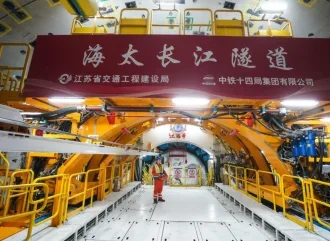
The TBM that will bore one of the world’s longest underwater road tunnels has been launched in China.
TBM Jianghai will construct the Haitai Yangtze River Tunnel in east China’s Jiangsu Province. The tunnel is a key project for a major trans-river road link under China’s longest river, connecting Haimen in the city of Nantong with Taicang in the city of Suzhou.
The TBM has a maximum excavation diameter of 16.6m. It is approximately 145m long and weighs 5,000 tonnes. Jianghai was designed and developed by China Railway Construction Heavy Industry Corp in collaboration with China Railway 14th Bureau Group.
Stretching approximately 39.07km in total, the tunnel includes an 11.18km underwater section, with 9.3km to be excavated by TBM. It is designed as a six-lane, bi-directional highway with a speed limit of 100km/h.
The tunnel alignment travels through complex geological formations beneath the riverbed, including layers of silt and fine sand. It will reach a maximum depth of 75m, subjecting it to pressure equivalent to 75 tonnes per square metre, according to You Shaoqiang, chief engineer of the tunnel project of China Railway 14th Bureau.
“These harsh conditions make the construction process extremely challenging,” he said.
To tackle these conditions, TBM Jianghai is equipped with a pressure-balanced cutterhead and an intelligent monitoring system that enables real-time monitoring of cutterhead wear and facilitates tool repair or replacement within the underwater working cabin. It also features dual slurry injection to improve efficiency, said Meng Defeng, TBM manager for the project.
The project team has devised a segmented smoke extraction system to mitigate fire risks. They have also incorporated a dedicated rescue vehicle access tunnel, which is connected to the main tunnel via corridors, for swift rescue operations without disrupting other traffic in the tunnel.
“The tunnel boasts multiple pioneering features in structural design, disaster prevention, equipment, green technology, and intelligent systems, with its construction designed to be close to carbon neutral,” said Chen Junwei, a manager of the tunnel project.
The tunnel is expected to be completed in 2028.







